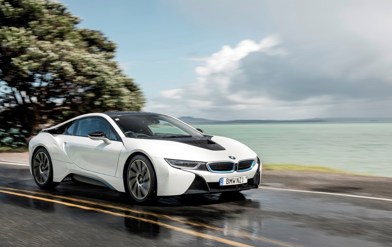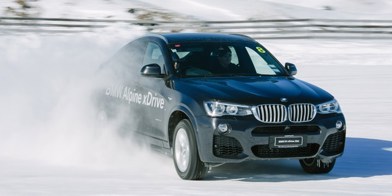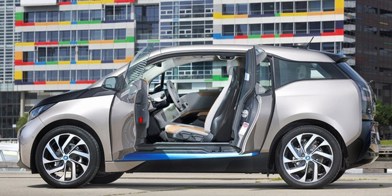Is the new Lexus RZ 450e pure-electric SUV part of the same family as the RX we’ve known for so long? Yes, definitely. Although technically, no, not really.

Luxury electrified SUVs are nothing new for Lexus. Toyota’s upmarket division has been doing them since 2006, when it launched the first RX 400h. If we’re really giving credit where credit where credit is due, it wasn’t just the brand’s first; it was the world’s first luxury/performance hybrid.
There’s now an all-new RX, the fifth generation, and because it’s 2023 it’s arrived in New Zealand in hybrid form only. There’s the 350h, which is really an evolution of the RX-concept we’re all familiar with; but there’s also a new 500h F Sport (above), which really ramps up the technology with a turbocharged engine (a first for a Lexus hybrid), proper six-speed automatic gearbox (the 350h sticks with continuously variable transmission) and a wealth of clever chassis stuff, including a new super-responsive AWD system called Direct4 and four-wheel steering.

On paper, the RZ 450e (above) is a completely different thing. It’s based on a bespoke battery electric vehicle platform called e-TNGA (same as Toyota’s forthcoming BZ4X, which we won’t see until 2024) and shares no body panels with the RX. It’s 85mm shorter and 60mm lower.
And yet, it’s all in the family. There’s a similar look across the two models: the RX has a conventional grille, but it really does mimic an EV look; the RZ’s front is flush, but retains the signature Lexus “spindle” grille shape.

The wheelbase and much of the interior architecture is shared across the two ranges, the biggest difference being a conventional gearlever for the RX versus a dial-type shifter for the RZ (above).
More to the point, the two ranges are stepped to fit perfectly together. The RX 350h AWD opens at $120,900, or $131,900 for the more luxurious Limited (to which you can add a $4000 Enhancement Pack, which includes digital rearvision mirror, full self-parking and panoramic roof).

The 500h F Sport is $142,900 and comes with… everything.
The top of the RX range neatly clips to the RZ 450e, which is $141,900 in Core specification or $151,600 as the Dynamic, which adds the likes of UltraSuede upholstery, seat ventilation/memory, heated rear chairs, touch-sensitive steering wheel switches, more comprehensive displays and even a “Radiant Heater” that focuses more on heating the occupants than the cabin.

There’s also a $2000 bi-tone exterior finish option on either RZ, which looks pretty cool. The Core/Dynamic names and fancy two-tone colour scheme are reserved for the pure-electric model.
We sampled each of the three powertrain variants on an introductory drive programme from Dunedin to Queenstown. A brief time in each, but enough to get the individual flavours.

The RX is massive step up in terms of design, but the 350h (above) will be a comforting feeling for anybody coming out of the previous model. The petrol engine has downsized from the 3.5-litre V6 of the previous 450h (yes, all the numbers do get confusing) to a 2.5-litre four, so it’s significantly less powerful; but 184kW is still plenty for a luxury oriented SUV and you cannot deny the incredible blend of refinement and fuel economy in this model. The RX has always had a high swish-factor and this one keeps the faith.
The interior has certainly made a bold leap into the future, with a massive 14-inch touch screen in the style of the smaller NX; imposing at first, but actually the OS is nicely intuitive and the graphics impressively crisp.

“F Sport” is a familiar brand for Lexus, but the 500h F Sport (above left, with the 350h on the right) is a completely new kind of RX: one that actually has sporty aspirations, with 2.4-litre turbo power (note the petrol engine is also different from the 350h), that fancy AWD system and 4WS (the front/rear wheels go in opposite direction at low speed to make the car more agile, and in the same direction at higher speeds for smoother cornering/lane-changing).
First impressions suggest the 500h is still primarily a luxury SUV, and we don’t mean that in a bad way: the powertrain is silky smooth and the chassis technology delivers that extra performance in an absolutely effortless way. It’s a true grand tourer, eating up demanding roads at high speed and seldom raising a sweat (car or driver).

The pure-electric RZ 450e (above) is quicker still, but similarly smooth – almost reserved – in the way it delivers that performance. It’s very “Lexus” and on paper, a credible rival to similarly priced luxury BEVs like the Audi e-tron, BMW iX, Jaguar I-Pace and Mercedes-Benz EQC.
Our time in the RZ was the shortest of the trio – a short hop from the Clyde Dam to Queenstown, sharing driving across three occupants. It’s seductively quiet and spacious of course, and the sleeker, more aerodynamic body shape beats the RX for style hands down (check out the fins atop the tailgate).

It feels suitably nimble, too; it might surprise that the 450e is actually 110kg lighter than the 500h.
There is an elephant in the room and that’s real-world range, which is a big thing for customers transitioning from conventional petrol or hybrid cars. The RZ’s 71kWh battery is small by class standards and it remains to be seen how the quoted 470km range (under the fairly relaxed NEDC standard) translates to the real world. Nor does the 150kW maximum charge rate match the 200kW-plus offered by other premium BEVs (on the right DC hyper charger, of course).
But that can all wait until proper road-test time. For now, this is a very important range of models for Lexus, which aims to grow 150 per cent from 1500 cars this year to 2500 in 2025.
It’s important for parent brand Toyota NZ to achieve that, and not just because selling expensive cars generates lots of profit. Lexus is already predominantly electrified in NZ (89 per cent of sales last month) and even though it only comprises 5 per cent of Toyota’s total volume, it contributes 20 per cent of the company’s credits under the Government’s Clean Car Standard.
By the way, that’s RX for “crossover” and RZ for “Zero emissions”. Simple.
LEXUS RX/RZ
ENGINES: 2.5-litre (350h) or 2.4-litre turbo-petrol (500h) fours with hybrid system, 71.4kWh battery with dual electric motors (450e).
POWER: 184kW combined/239Nm (350h), 273kW combined/460Nm (500h), 150kW/266Nm front and 80kW/168Nm rear (450e).
GEARBOX: Continuously variable with E-Four AWD (350h), 6-speed automatic with Direct4 AWD (500h), single-speed with Direct4 AWD (450e).
0-100KM/H: 7.9sec (350h), 6.2sec (500h), 5.3sec (450e).
CONSUMPTION: 6.0l/100km (350h), 7.2l/100km (500h), all figures 3P-WLTP; 15.2kWh/100km, range 470km (450e), all figures NEDC.
PRICE: $120,900-$151,600.





